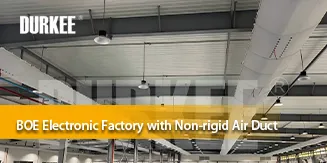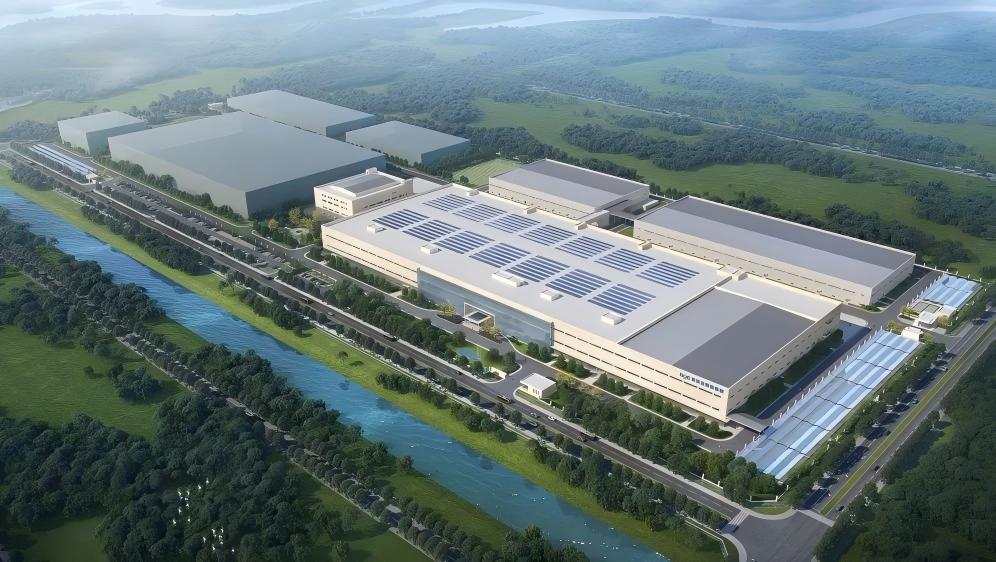 BOE Vietnam Factory: Non-rigid Air Duct Solutions for Electronic Industry
BOE Vietnam Factory: Non-rigid Air Duct Solutions for Electronic Industry
 Why Fabric Air Ducts Are the Preferred Choice for Ventilation in Large Spaces
Why Fabric Air Ducts Are the Preferred Choice for Ventilation in Large Spaces
 The Difference Between Non-Rigid Air Ducts and Rigid Ductwork
The Difference Between Non-Rigid Air Ducts and Rigid Ductwork
For global electronic manufacturers, building overseas smart factories means balancing two non-negotiables: strict cleanroom and energy standards (critical for precision components) and tight construction timelines (to capture market opportunities). BOE— a leader in display and smart terminal technology—faced this exact challenge with its first overseas self-invested smart factory in Vietnam.

This factory designed to produce 3M TVs, 7M monitors, and 40M e-paper devices annually, overcame delays and structural limits with a targeted HVAC upgrade. This case study breaks down how Durkduct® non-rigid pre-insulated air ducts solved the factory’s unique pain points, accelerated mass production by 2.5 months, and created a blueprint for electronic industry HVAC in Southeast Asia.
1. Project Overview: BOE Vietnam Smart Terminal Phase II
Key Detail | Specifications |
Location | Ho Chi Minh City Industrial Zone, Vietnam |
Total Investment | 2.02 billion RMB |
Annual Production Capacity | 3M TVs, 7M monitors, 40M e-paper devices |
Original Mass Production Target | Late 2025 |
Actual Mass Production Date | June 2025 (2.5 months early) |
HVAC Scope | 130,000 m² total ductwork; 97,000 m² converted to Durkduct® non-rigid/pre-insulated ducts |
Industry Focus | Precision electronic terminal manufacturing |
1.1 Why This Project Matters for Electronic Industry HVAC
As BOE’s first overseas self-built smart factory, it serves as a technical benchmark for electronic manufacturing in Southeast Asia. Unlike general industrial projects, electronic facilities demand ultra-clean air, and anti-condensation control — all of which traditional rigid galvanized iron (GI) ducts struggle to deliver. The project’s success directly relied on replacing outdated rigid GI ducts with Durkduct® non-rigid pre-insulated air duct alternatives.
2. Project Challenges: Why Traditional GI Ducts Failed
2.1 Critical Constraints the HVAC System Had to Overcome
1) Structural Load Limits: The factory's brick-concrete structure and steel-sheet roof could not support heavy rigid GI ducts. For electronic facilities (which often require additional equipment like cleanroom filters), extra weight risked structural damage and project delays.
2) 100,000-Class Cleanroom Requirements: Electronic component production demands 100,000-class cleanliness. Traditional GI ducts leak air and accumulate dust; they also cause condensation (which damages sensitive electronics).
3) Time & Energy Pressures: On-site insulation for GI ducts would add 4+ weeks to construction—critical for a project aiming to launch production early. Electronic factories also need energy efficiency (to power 24/7 operations), and GI ducts require separate insulation (increasing energy loss).
4) Noise Control: Office areas and equipment rooms (housing servers for production lines) need low noise. Rigid GI ducts vibrate during operation, amplifying sound and disrupting both workers and sensitive electronic systems.
2.2 Solution: Durkduct®-I series Non-Rigid & Pre-Insulated Air Ducts for Electronic Factories
Key benefits for electronic production:
1) Lightweight and Cost Saving: 80% lighter than rigid GI ducts, and cutting installation time for the 97,000 m² duct system by 40%. For electronic factories, this speed directly contributed to the 2.5-month early production launch.
2) Uniform Air Distribution: critical for large electronic warehouses and assembly lines, where inconsistent air can cause temperature fluctuations (damaging components).
3) Space-Saving Design: non-rigid ducts leave room for cleanroom filters, cable trays, and maintenance access—essential for electronic factories with dense layouts
4) Exceeds 100,000-Class Cleanliness: High-airtightness connections prevent air leaks and dust buildup—meeting the strict cleanroom standards for electronic components.
5) Anti-Condensation Control: The integrated insulation blocks temperature transfer, eliminating condensation (a top risk for short-circuiting electronic equipment).
6) BIM Modular Design & Factory Prefabrication: All Durkduct® non-rigid pre-insulated ducts were designed via BIM modular technology and 100% factory-prefabricated, enabled concurrent work with clean room and equipment teams, avoiding on-site delays.
.png)
3. Key Results: Data-Driven Success for BOE
3.1 Key Metrics the Solution Achieved
Outcome | Impact |
Construction Timeline | 2.5 months faster (mass production moved to June 2025) – critical for capturing Q3 electronic market demand |
Labor Costs | 50% reduction (via BIM prefabrication) – freed budget for clean room upgrades |
Energy Consumption | 15% lower (vs. traditional GI ducts) – reduced costs for 24/7 electronic production operations |
Maintenance Costs | 20% lower (due to durable non-rigid fabric and anti-condensation insulation) – less downtime for electronic assembly lines |
Cleanliness Compliance | Exceeded 100,000-class standards – no component damage from dust or condensation |
4. User Testimonial: BOE's Electronic Production Team
“The Durkduct® non-rigid pre-insulated air ducts were game-changers for our Vietnam factory,” said a BOE project manager. “They solved our structural load issues, cut construction time by 2.5 months, and most importantly, kept our clean rooms compliant—ensuring stable conditions for our precision electronic assembly lines. We now recommend this solution for all our overseas electronic smart factories.”
5. Conclusion: Your Blueprint for Electronic Factory HVAC
BOE's Vietnam project proves that non-rigid air ducts aren't just HVAC components—they're strategic tools for electronic manufacturers building overseas. Unlike traditional GI ducts, they address the unique needs of electronic production: clean room compliance, anti-condensation control, structural flexibility, and speed.
For electronic manufacturers:
If your facility faces structural limits (no heavy GI ducts), if you need to meet 100,000-class cleanrooms and launch production early, non-rigid air ducts are the solution save time and reduce risk.
Ready to replicate BOE's success? Contact our team to assess your electronic factory's HVAC needs.
.png)